Research Proposal: Media's Impact on Children's Development
VerifiedAdded on 2022/10/06
|10
|2901
|84
Project
AI Summary
This research proposal examines the positive and negative effects of media on children and adolescents. The study explores the influence of digital media, including television, computers, smartphones, and social media, on children's psychological development. It highlights both the benefits, such as educational applications and games, and the detriments, like obesity, sleep disorders, and exposure to inappropriate content. The research will involve 100 children and adolescents aged 10-16, divided into groups based on their media usage patterns. Data will be collected through questionnaires using a Likert scale, and an observational study will be conducted to gather background information. The study anticipates using ANOVA to analyze the data, aiming to determine the correlation between media use and behavioral traits. The study acknowledges limitations like potential biases from parental perceptions and the age of participants. The anticipated results are expected to reject the null hypothesis and support the primary hypothesis that media sources influence children and adolescents, with implications for future research.
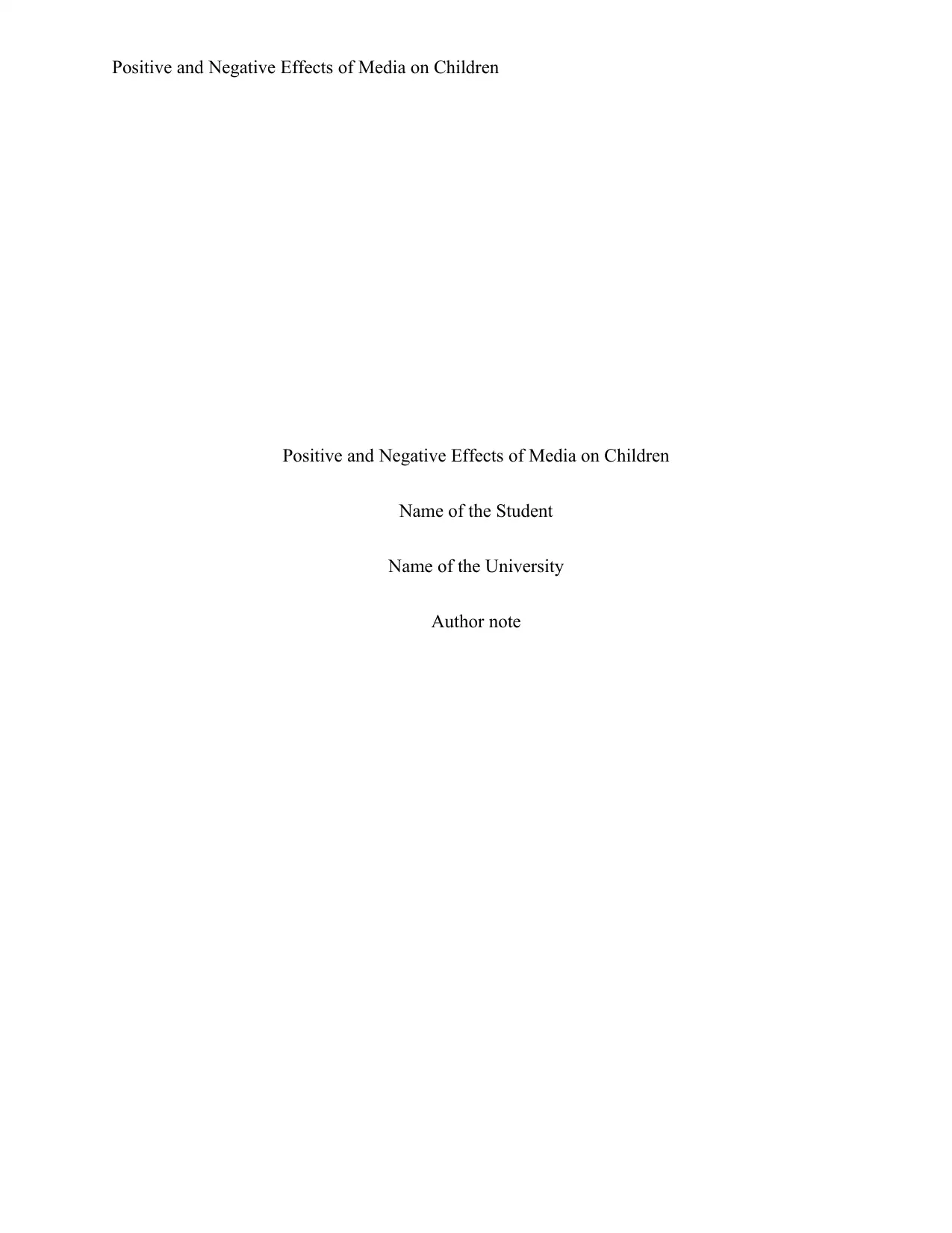
Positive and Negative Effects of Media on Children
Positive and Negative Effects of Media on Children
Name of the Student
Name of the University
Author note
Positive and Negative Effects of Media on Children
Name of the Student
Name of the University
Author note
Paraphrase This Document
Need a fresh take? Get an instant paraphrase of this document with our AI Paraphraser
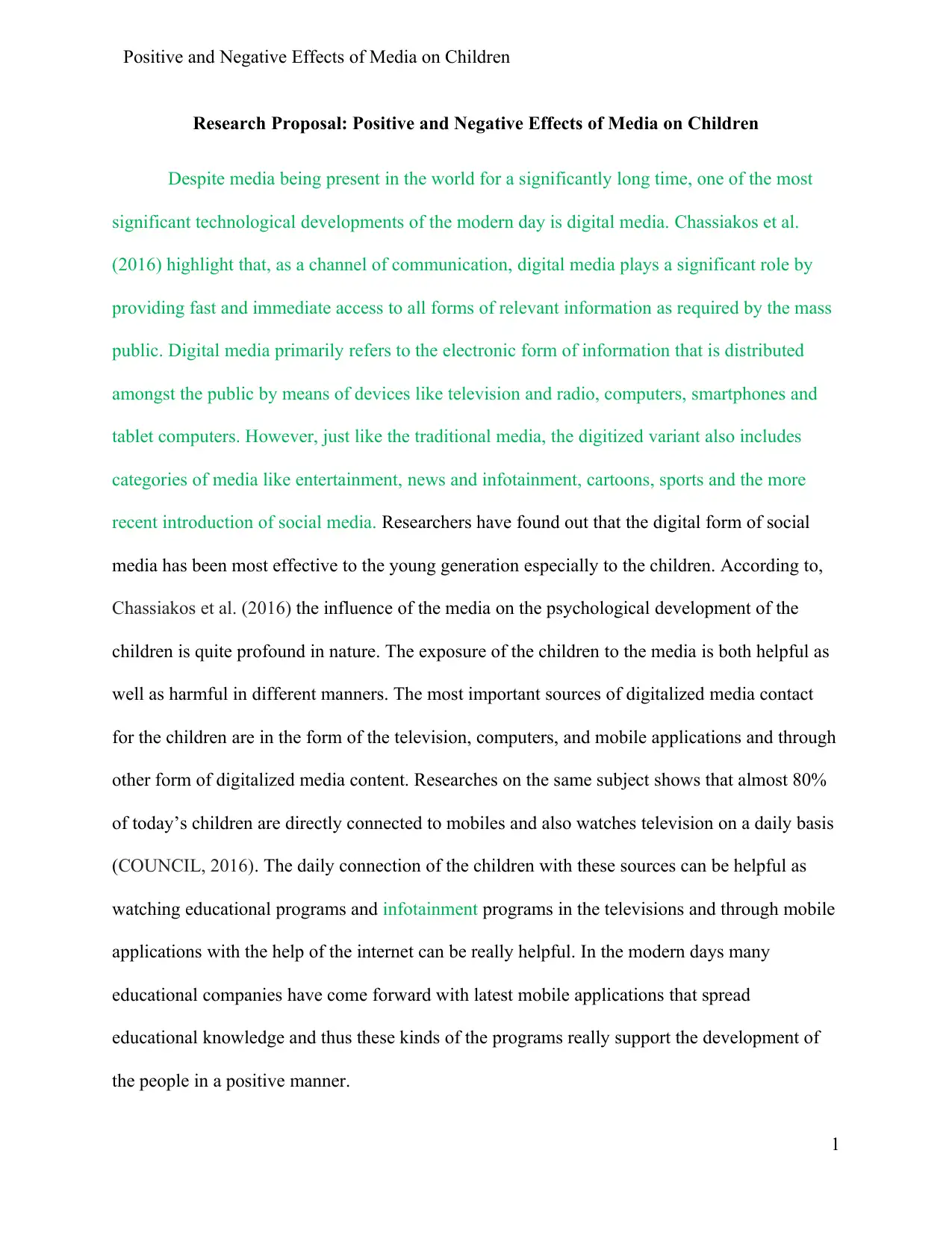
Positive and Negative Effects of Media on Children
Research Proposal: Positive and Negative Effects of Media on Children
Despite media being present in the world for a significantly long time, one of the most
significant technological developments of the modern day is digital media. Chassiakos et al.
(2016) highlight that, as a channel of communication, digital media plays a significant role by
providing fast and immediate access to all forms of relevant information as required by the mass
public. Digital media primarily refers to the electronic form of information that is distributed
amongst the public by means of devices like television and radio, computers, smartphones and
tablet computers. However, just like the traditional media, the digitized variant also includes
categories of media like entertainment, news and infotainment, cartoons, sports and the more
recent introduction of social media. Researchers have found out that the digital form of social
media has been most effective to the young generation especially to the children. According to,
Chassiakos et al. (2016) the influence of the media on the psychological development of the
children is quite profound in nature. The exposure of the children to the media is both helpful as
well as harmful in different manners. The most important sources of digitalized media contact
for the children are in the form of the television, computers, and mobile applications and through
other form of digitalized media content. Researches on the same subject shows that almost 80%
of today’s children are directly connected to mobiles and also watches television on a daily basis
(COUNCIL, 2016). The daily connection of the children with these sources can be helpful as
watching educational programs and infotainment programs in the televisions and through mobile
applications with the help of the internet can be really helpful. In the modern days many
educational companies have come forward with latest mobile applications that spread
educational knowledge and thus these kinds of the programs really support the development of
the people in a positive manner.
1
Research Proposal: Positive and Negative Effects of Media on Children
Despite media being present in the world for a significantly long time, one of the most
significant technological developments of the modern day is digital media. Chassiakos et al.
(2016) highlight that, as a channel of communication, digital media plays a significant role by
providing fast and immediate access to all forms of relevant information as required by the mass
public. Digital media primarily refers to the electronic form of information that is distributed
amongst the public by means of devices like television and radio, computers, smartphones and
tablet computers. However, just like the traditional media, the digitized variant also includes
categories of media like entertainment, news and infotainment, cartoons, sports and the more
recent introduction of social media. Researchers have found out that the digital form of social
media has been most effective to the young generation especially to the children. According to,
Chassiakos et al. (2016) the influence of the media on the psychological development of the
children is quite profound in nature. The exposure of the children to the media is both helpful as
well as harmful in different manners. The most important sources of digitalized media contact
for the children are in the form of the television, computers, and mobile applications and through
other form of digitalized media content. Researches on the same subject shows that almost 80%
of today’s children are directly connected to mobiles and also watches television on a daily basis
(COUNCIL, 2016). The daily connection of the children with these sources can be helpful as
watching educational programs and infotainment programs in the televisions and through mobile
applications with the help of the internet can be really helpful. In the modern days many
educational companies have come forward with latest mobile applications that spread
educational knowledge and thus these kinds of the programs really support the development of
the people in a positive manner.
1
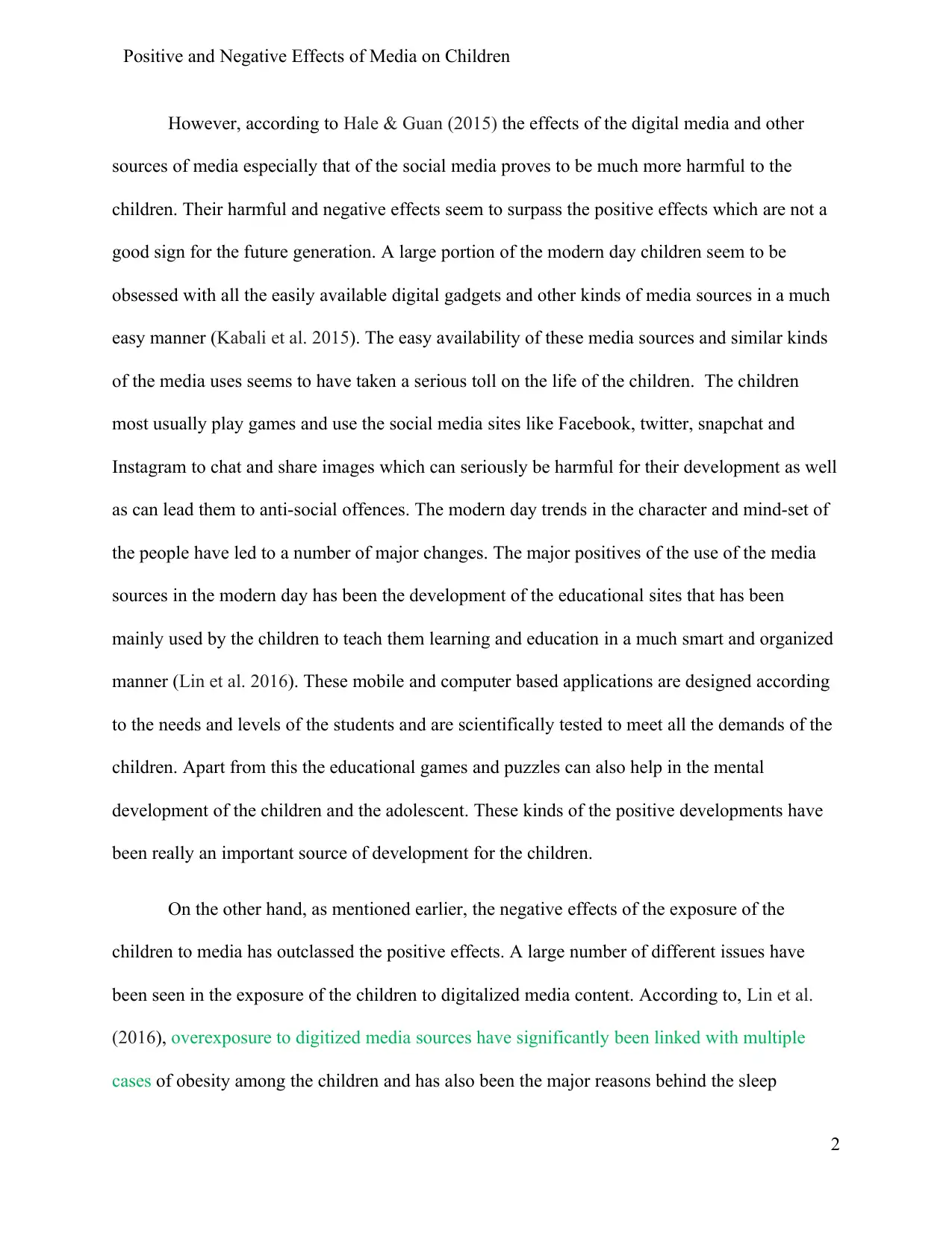
Positive and Negative Effects of Media on Children
However, according to Hale & Guan (2015) the effects of the digital media and other
sources of media especially that of the social media proves to be much more harmful to the
children. Their harmful and negative effects seem to surpass the positive effects which are not a
good sign for the future generation. A large portion of the modern day children seem to be
obsessed with all the easily available digital gadgets and other kinds of media sources in a much
easy manner (Kabali et al. 2015). The easy availability of these media sources and similar kinds
of the media uses seems to have taken a serious toll on the life of the children. The children
most usually play games and use the social media sites like Facebook, twitter, snapchat and
Instagram to chat and share images which can seriously be harmful for their development as well
as can lead them to anti-social offences. The modern day trends in the character and mind-set of
the people have led to a number of major changes. The major positives of the use of the media
sources in the modern day has been the development of the educational sites that has been
mainly used by the children to teach them learning and education in a much smart and organized
manner (Lin et al. 2016). These mobile and computer based applications are designed according
to the needs and levels of the students and are scientifically tested to meet all the demands of the
children. Apart from this the educational games and puzzles can also help in the mental
development of the children and the adolescent. These kinds of the positive developments have
been really an important source of development for the children.
On the other hand, as mentioned earlier, the negative effects of the exposure of the
children to media has outclassed the positive effects. A large number of different issues have
been seen in the exposure of the children to digitalized media content. According to, Lin et al.
(2016), overexposure to digitized media sources have significantly been linked with multiple
cases of obesity among the children and has also been the major reasons behind the sleep
2
However, according to Hale & Guan (2015) the effects of the digital media and other
sources of media especially that of the social media proves to be much more harmful to the
children. Their harmful and negative effects seem to surpass the positive effects which are not a
good sign for the future generation. A large portion of the modern day children seem to be
obsessed with all the easily available digital gadgets and other kinds of media sources in a much
easy manner (Kabali et al. 2015). The easy availability of these media sources and similar kinds
of the media uses seems to have taken a serious toll on the life of the children. The children
most usually play games and use the social media sites like Facebook, twitter, snapchat and
Instagram to chat and share images which can seriously be harmful for their development as well
as can lead them to anti-social offences. The modern day trends in the character and mind-set of
the people have led to a number of major changes. The major positives of the use of the media
sources in the modern day has been the development of the educational sites that has been
mainly used by the children to teach them learning and education in a much smart and organized
manner (Lin et al. 2016). These mobile and computer based applications are designed according
to the needs and levels of the students and are scientifically tested to meet all the demands of the
children. Apart from this the educational games and puzzles can also help in the mental
development of the children and the adolescent. These kinds of the positive developments have
been really an important source of development for the children.
On the other hand, as mentioned earlier, the negative effects of the exposure of the
children to media has outclassed the positive effects. A large number of different issues have
been seen in the exposure of the children to digitalized media content. According to, Lin et al.
(2016), overexposure to digitized media sources have significantly been linked with multiple
cases of obesity among the children and has also been the major reasons behind the sleep
2
⊘ This is a preview!⊘
Do you want full access?
Subscribe today to unlock all pages.

Trusted by 1+ million students worldwide
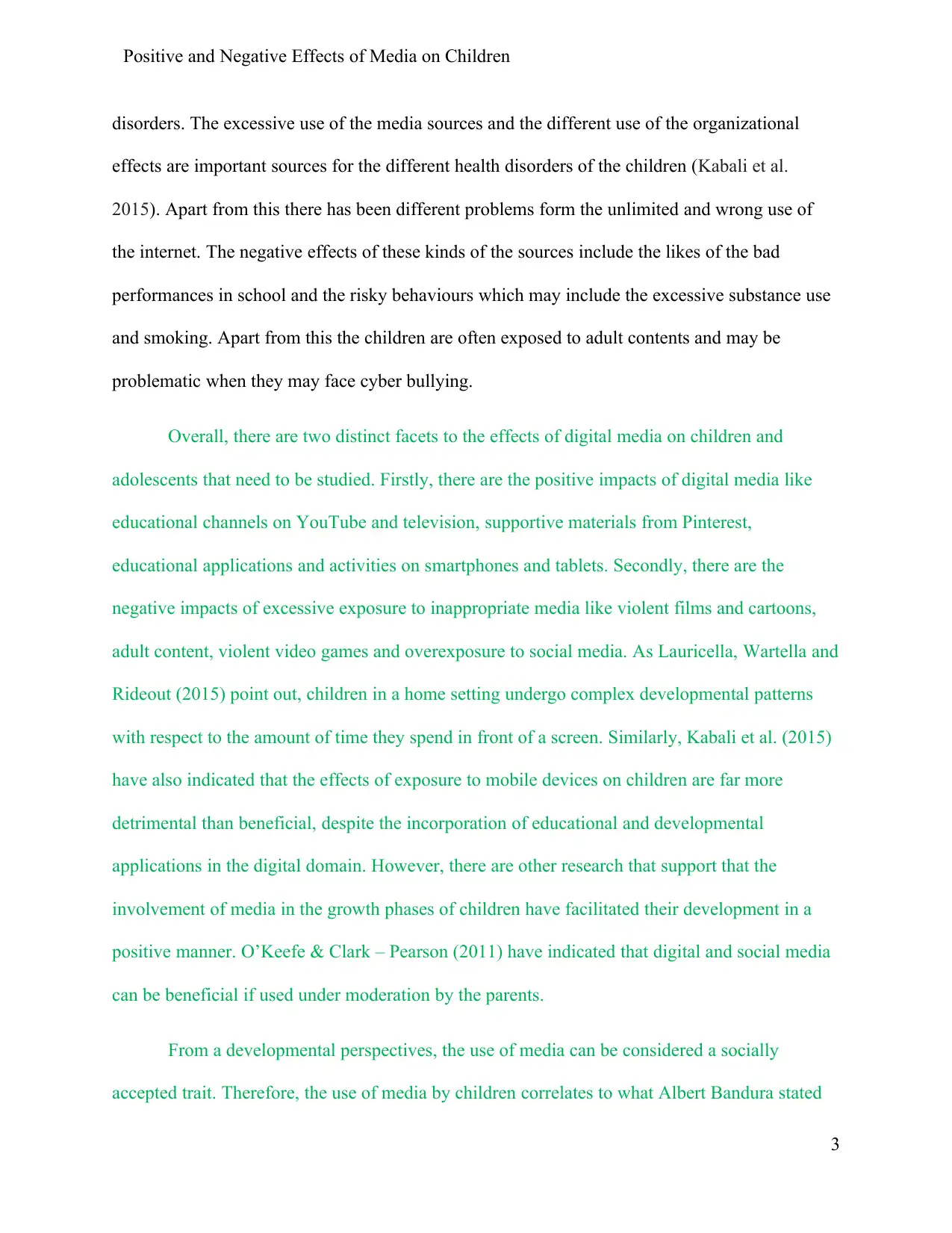
Positive and Negative Effects of Media on Children
disorders. The excessive use of the media sources and the different use of the organizational
effects are important sources for the different health disorders of the children (Kabali et al.
2015). Apart from this there has been different problems form the unlimited and wrong use of
the internet. The negative effects of these kinds of the sources include the likes of the bad
performances in school and the risky behaviours which may include the excessive substance use
and smoking. Apart from this the children are often exposed to adult contents and may be
problematic when they may face cyber bullying.
Overall, there are two distinct facets to the effects of digital media on children and
adolescents that need to be studied. Firstly, there are the positive impacts of digital media like
educational channels on YouTube and television, supportive materials from Pinterest,
educational applications and activities on smartphones and tablets. Secondly, there are the
negative impacts of excessive exposure to inappropriate media like violent films and cartoons,
adult content, violent video games and overexposure to social media. As Lauricella, Wartella and
Rideout (2015) point out, children in a home setting undergo complex developmental patterns
with respect to the amount of time they spend in front of a screen. Similarly, Kabali et al. (2015)
have also indicated that the effects of exposure to mobile devices on children are far more
detrimental than beneficial, despite the incorporation of educational and developmental
applications in the digital domain. However, there are other research that support that the
involvement of media in the growth phases of children have facilitated their development in a
positive manner. O’Keefe & Clark – Pearson (2011) have indicated that digital and social media
can be beneficial if used under moderation by the parents.
From a developmental perspectives, the use of media can be considered a socially
accepted trait. Therefore, the use of media by children correlates to what Albert Bandura stated
3
disorders. The excessive use of the media sources and the different use of the organizational
effects are important sources for the different health disorders of the children (Kabali et al.
2015). Apart from this there has been different problems form the unlimited and wrong use of
the internet. The negative effects of these kinds of the sources include the likes of the bad
performances in school and the risky behaviours which may include the excessive substance use
and smoking. Apart from this the children are often exposed to adult contents and may be
problematic when they may face cyber bullying.
Overall, there are two distinct facets to the effects of digital media on children and
adolescents that need to be studied. Firstly, there are the positive impacts of digital media like
educational channels on YouTube and television, supportive materials from Pinterest,
educational applications and activities on smartphones and tablets. Secondly, there are the
negative impacts of excessive exposure to inappropriate media like violent films and cartoons,
adult content, violent video games and overexposure to social media. As Lauricella, Wartella and
Rideout (2015) point out, children in a home setting undergo complex developmental patterns
with respect to the amount of time they spend in front of a screen. Similarly, Kabali et al. (2015)
have also indicated that the effects of exposure to mobile devices on children are far more
detrimental than beneficial, despite the incorporation of educational and developmental
applications in the digital domain. However, there are other research that support that the
involvement of media in the growth phases of children have facilitated their development in a
positive manner. O’Keefe & Clark – Pearson (2011) have indicated that digital and social media
can be beneficial if used under moderation by the parents.
From a developmental perspectives, the use of media can be considered a socially
accepted trait. Therefore, the use of media by children correlates to what Albert Bandura stated
3
Paraphrase This Document
Need a fresh take? Get an instant paraphrase of this document with our AI Paraphraser
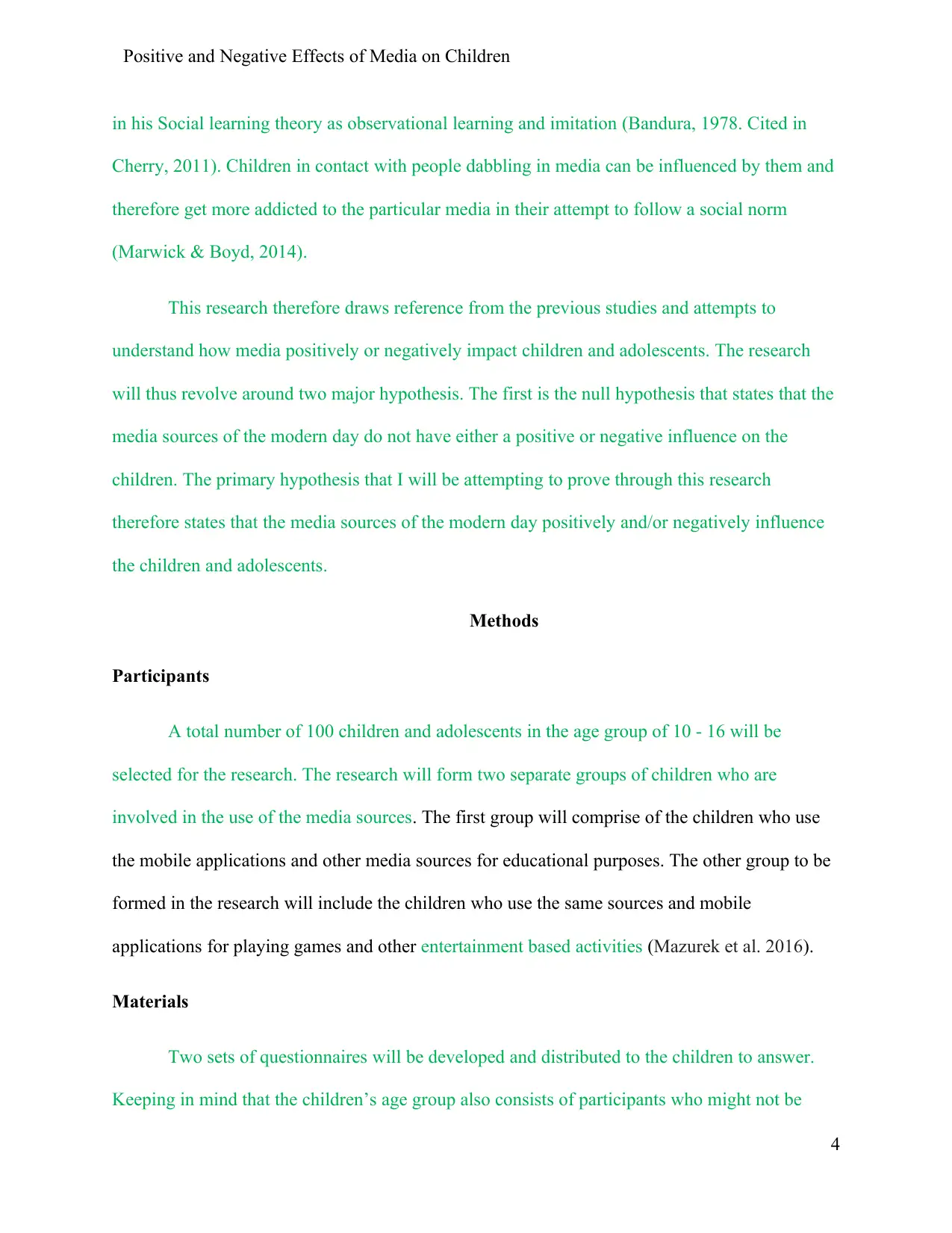
Positive and Negative Effects of Media on Children
in his Social learning theory as observational learning and imitation (Bandura, 1978. Cited in
Cherry, 2011). Children in contact with people dabbling in media can be influenced by them and
therefore get more addicted to the particular media in their attempt to follow a social norm
(Marwick & Boyd, 2014).
This research therefore draws reference from the previous studies and attempts to
understand how media positively or negatively impact children and adolescents. The research
will thus revolve around two major hypothesis. The first is the null hypothesis that states that the
media sources of the modern day do not have either a positive or negative influence on the
children. The primary hypothesis that I will be attempting to prove through this research
therefore states that the media sources of the modern day positively and/or negatively influence
the children and adolescents.
Methods
Participants
A total number of 100 children and adolescents in the age group of 10 - 16 will be
selected for the research. The research will form two separate groups of children who are
involved in the use of the media sources. The first group will comprise of the children who use
the mobile applications and other media sources for educational purposes. The other group to be
formed in the research will include the children who use the same sources and mobile
applications for playing games and other entertainment based activities (Mazurek et al. 2016).
Materials
Two sets of questionnaires will be developed and distributed to the children to answer.
Keeping in mind that the children’s age group also consists of participants who might not be
4
in his Social learning theory as observational learning and imitation (Bandura, 1978. Cited in
Cherry, 2011). Children in contact with people dabbling in media can be influenced by them and
therefore get more addicted to the particular media in their attempt to follow a social norm
(Marwick & Boyd, 2014).
This research therefore draws reference from the previous studies and attempts to
understand how media positively or negatively impact children and adolescents. The research
will thus revolve around two major hypothesis. The first is the null hypothesis that states that the
media sources of the modern day do not have either a positive or negative influence on the
children. The primary hypothesis that I will be attempting to prove through this research
therefore states that the media sources of the modern day positively and/or negatively influence
the children and adolescents.
Methods
Participants
A total number of 100 children and adolescents in the age group of 10 - 16 will be
selected for the research. The research will form two separate groups of children who are
involved in the use of the media sources. The first group will comprise of the children who use
the mobile applications and other media sources for educational purposes. The other group to be
formed in the research will include the children who use the same sources and mobile
applications for playing games and other entertainment based activities (Mazurek et al. 2016).
Materials
Two sets of questionnaires will be developed and distributed to the children to answer.
Keeping in mind that the children’s age group also consists of participants who might not be
4
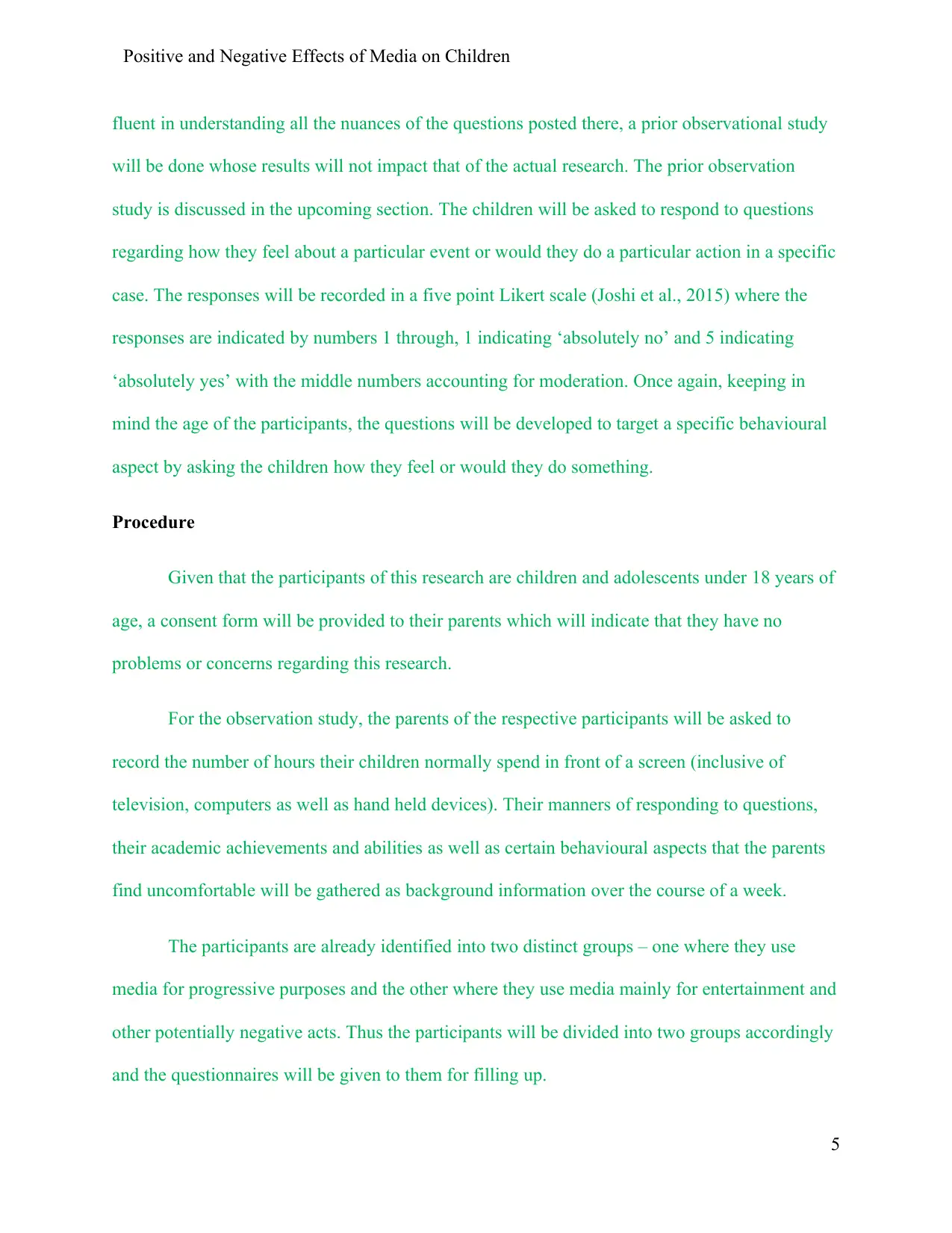
Positive and Negative Effects of Media on Children
fluent in understanding all the nuances of the questions posted there, a prior observational study
will be done whose results will not impact that of the actual research. The prior observation
study is discussed in the upcoming section. The children will be asked to respond to questions
regarding how they feel about a particular event or would they do a particular action in a specific
case. The responses will be recorded in a five point Likert scale (Joshi et al., 2015) where the
responses are indicated by numbers 1 through, 1 indicating ‘absolutely no’ and 5 indicating
‘absolutely yes’ with the middle numbers accounting for moderation. Once again, keeping in
mind the age of the participants, the questions will be developed to target a specific behavioural
aspect by asking the children how they feel or would they do something.
Procedure
Given that the participants of this research are children and adolescents under 18 years of
age, a consent form will be provided to their parents which will indicate that they have no
problems or concerns regarding this research.
For the observation study, the parents of the respective participants will be asked to
record the number of hours their children normally spend in front of a screen (inclusive of
television, computers as well as hand held devices). Their manners of responding to questions,
their academic achievements and abilities as well as certain behavioural aspects that the parents
find uncomfortable will be gathered as background information over the course of a week.
The participants are already identified into two distinct groups – one where they use
media for progressive purposes and the other where they use media mainly for entertainment and
other potentially negative acts. Thus the participants will be divided into two groups accordingly
and the questionnaires will be given to them for filling up.
5
fluent in understanding all the nuances of the questions posted there, a prior observational study
will be done whose results will not impact that of the actual research. The prior observation
study is discussed in the upcoming section. The children will be asked to respond to questions
regarding how they feel about a particular event or would they do a particular action in a specific
case. The responses will be recorded in a five point Likert scale (Joshi et al., 2015) where the
responses are indicated by numbers 1 through, 1 indicating ‘absolutely no’ and 5 indicating
‘absolutely yes’ with the middle numbers accounting for moderation. Once again, keeping in
mind the age of the participants, the questions will be developed to target a specific behavioural
aspect by asking the children how they feel or would they do something.
Procedure
Given that the participants of this research are children and adolescents under 18 years of
age, a consent form will be provided to their parents which will indicate that they have no
problems or concerns regarding this research.
For the observation study, the parents of the respective participants will be asked to
record the number of hours their children normally spend in front of a screen (inclusive of
television, computers as well as hand held devices). Their manners of responding to questions,
their academic achievements and abilities as well as certain behavioural aspects that the parents
find uncomfortable will be gathered as background information over the course of a week.
The participants are already identified into two distinct groups – one where they use
media for progressive purposes and the other where they use media mainly for entertainment and
other potentially negative acts. Thus the participants will be divided into two groups accordingly
and the questionnaires will be given to them for filling up.
5
⊘ This is a preview!⊘
Do you want full access?
Subscribe today to unlock all pages.

Trusted by 1+ million students worldwide
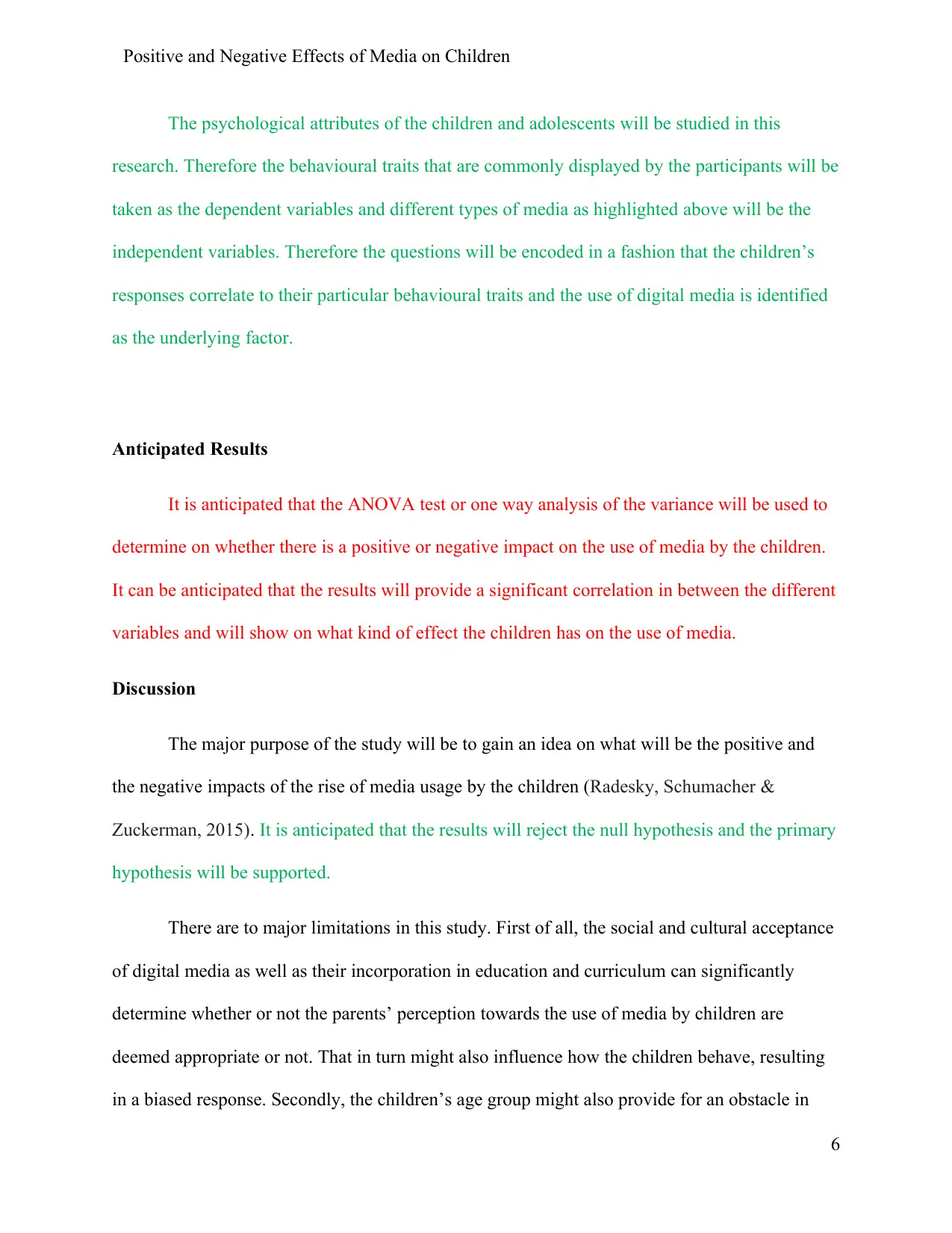
Positive and Negative Effects of Media on Children
The psychological attributes of the children and adolescents will be studied in this
research. Therefore the behavioural traits that are commonly displayed by the participants will be
taken as the dependent variables and different types of media as highlighted above will be the
independent variables. Therefore the questions will be encoded in a fashion that the children’s
responses correlate to their particular behavioural traits and the use of digital media is identified
as the underlying factor.
Anticipated Results
It is anticipated that the ANOVA test or one way analysis of the variance will be used to
determine on whether there is a positive or negative impact on the use of media by the children.
It can be anticipated that the results will provide a significant correlation in between the different
variables and will show on what kind of effect the children has on the use of media.
Discussion
The major purpose of the study will be to gain an idea on what will be the positive and
the negative impacts of the rise of media usage by the children (Radesky, Schumacher &
Zuckerman, 2015). It is anticipated that the results will reject the null hypothesis and the primary
hypothesis will be supported.
There are to major limitations in this study. First of all, the social and cultural acceptance
of digital media as well as their incorporation in education and curriculum can significantly
determine whether or not the parents’ perception towards the use of media by children are
deemed appropriate or not. That in turn might also influence how the children behave, resulting
in a biased response. Secondly, the children’s age group might also provide for an obstacle in
6
The psychological attributes of the children and adolescents will be studied in this
research. Therefore the behavioural traits that are commonly displayed by the participants will be
taken as the dependent variables and different types of media as highlighted above will be the
independent variables. Therefore the questions will be encoded in a fashion that the children’s
responses correlate to their particular behavioural traits and the use of digital media is identified
as the underlying factor.
Anticipated Results
It is anticipated that the ANOVA test or one way analysis of the variance will be used to
determine on whether there is a positive or negative impact on the use of media by the children.
It can be anticipated that the results will provide a significant correlation in between the different
variables and will show on what kind of effect the children has on the use of media.
Discussion
The major purpose of the study will be to gain an idea on what will be the positive and
the negative impacts of the rise of media usage by the children (Radesky, Schumacher &
Zuckerman, 2015). It is anticipated that the results will reject the null hypothesis and the primary
hypothesis will be supported.
There are to major limitations in this study. First of all, the social and cultural acceptance
of digital media as well as their incorporation in education and curriculum can significantly
determine whether or not the parents’ perception towards the use of media by children are
deemed appropriate or not. That in turn might also influence how the children behave, resulting
in a biased response. Secondly, the children’s age group might also provide for an obstacle in
6
Paraphrase This Document
Need a fresh take? Get an instant paraphrase of this document with our AI Paraphraser
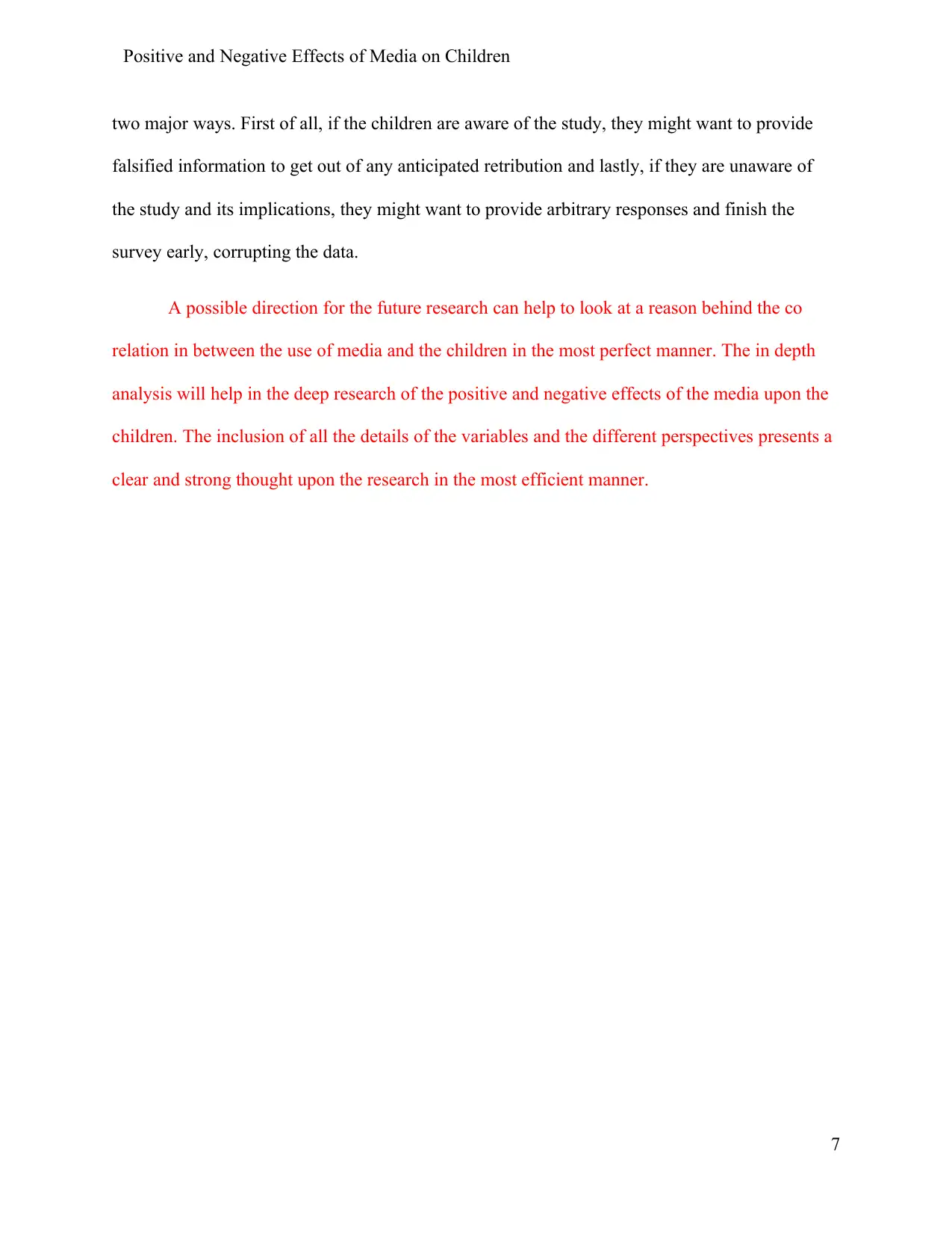
Positive and Negative Effects of Media on Children
two major ways. First of all, if the children are aware of the study, they might want to provide
falsified information to get out of any anticipated retribution and lastly, if they are unaware of
the study and its implications, they might want to provide arbitrary responses and finish the
survey early, corrupting the data.
A possible direction for the future research can help to look at a reason behind the co
relation in between the use of media and the children in the most perfect manner. The in depth
analysis will help in the deep research of the positive and negative effects of the media upon the
children. The inclusion of all the details of the variables and the different perspectives presents a
clear and strong thought upon the research in the most efficient manner.
7
two major ways. First of all, if the children are aware of the study, they might want to provide
falsified information to get out of any anticipated retribution and lastly, if they are unaware of
the study and its implications, they might want to provide arbitrary responses and finish the
survey early, corrupting the data.
A possible direction for the future research can help to look at a reason behind the co
relation in between the use of media and the children in the most perfect manner. The in depth
analysis will help in the deep research of the positive and negative effects of the media upon the
children. The inclusion of all the details of the variables and the different perspectives presents a
clear and strong thought upon the research in the most efficient manner.
7
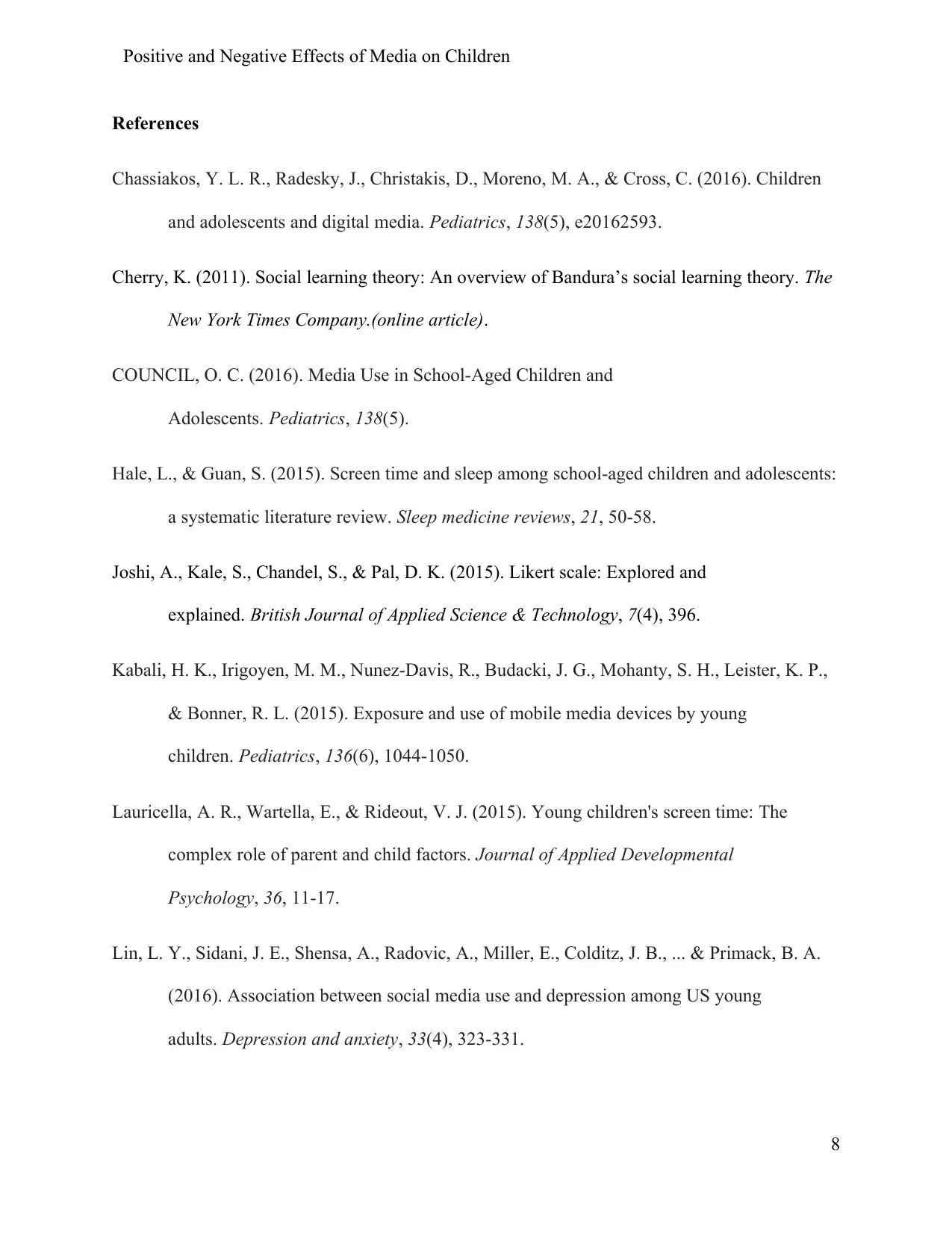
Positive and Negative Effects of Media on Children
References
Chassiakos, Y. L. R., Radesky, J., Christakis, D., Moreno, M. A., & Cross, C. (2016). Children
and adolescents and digital media. Pediatrics, 138(5), e20162593.
Cherry, K. (2011). Social learning theory: An overview of Bandura’s social learning theory. The
New York Times Company.(online article).
COUNCIL, O. C. (2016). Media Use in School-Aged Children and
Adolescents. Pediatrics, 138(5).
Hale, L., & Guan, S. (2015). Screen time and sleep among school-aged children and adolescents:
a systematic literature review. Sleep medicine reviews, 21, 50-58.
Joshi, A., Kale, S., Chandel, S., & Pal, D. K. (2015). Likert scale: Explored and
explained. British Journal of Applied Science & Technology, 7(4), 396.
Kabali, H. K., Irigoyen, M. M., Nunez-Davis, R., Budacki, J. G., Mohanty, S. H., Leister, K. P.,
& Bonner, R. L. (2015). Exposure and use of mobile media devices by young
children. Pediatrics, 136(6), 1044-1050.
Lauricella, A. R., Wartella, E., & Rideout, V. J. (2015). Young children's screen time: The
complex role of parent and child factors. Journal of Applied Developmental
Psychology, 36, 11-17.
Lin, L. Y., Sidani, J. E., Shensa, A., Radovic, A., Miller, E., Colditz, J. B., ... & Primack, B. A.
(2016). Association between social media use and depression among US young
adults. Depression and anxiety, 33(4), 323-331.
8
References
Chassiakos, Y. L. R., Radesky, J., Christakis, D., Moreno, M. A., & Cross, C. (2016). Children
and adolescents and digital media. Pediatrics, 138(5), e20162593.
Cherry, K. (2011). Social learning theory: An overview of Bandura’s social learning theory. The
New York Times Company.(online article).
COUNCIL, O. C. (2016). Media Use in School-Aged Children and
Adolescents. Pediatrics, 138(5).
Hale, L., & Guan, S. (2015). Screen time and sleep among school-aged children and adolescents:
a systematic literature review. Sleep medicine reviews, 21, 50-58.
Joshi, A., Kale, S., Chandel, S., & Pal, D. K. (2015). Likert scale: Explored and
explained. British Journal of Applied Science & Technology, 7(4), 396.
Kabali, H. K., Irigoyen, M. M., Nunez-Davis, R., Budacki, J. G., Mohanty, S. H., Leister, K. P.,
& Bonner, R. L. (2015). Exposure and use of mobile media devices by young
children. Pediatrics, 136(6), 1044-1050.
Lauricella, A. R., Wartella, E., & Rideout, V. J. (2015). Young children's screen time: The
complex role of parent and child factors. Journal of Applied Developmental
Psychology, 36, 11-17.
Lin, L. Y., Sidani, J. E., Shensa, A., Radovic, A., Miller, E., Colditz, J. B., ... & Primack, B. A.
(2016). Association between social media use and depression among US young
adults. Depression and anxiety, 33(4), 323-331.
8
⊘ This is a preview!⊘
Do you want full access?
Subscribe today to unlock all pages.

Trusted by 1+ million students worldwide
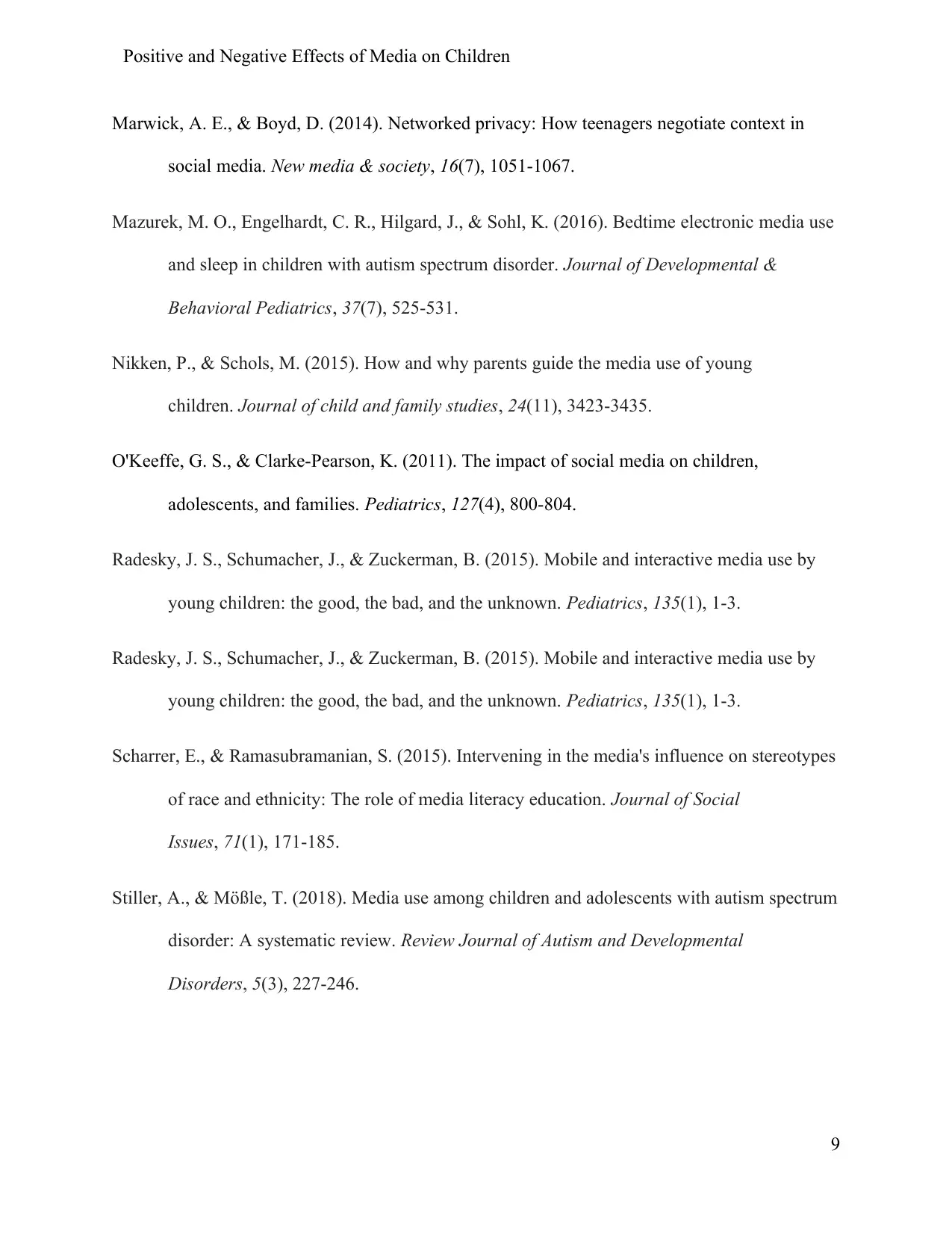
Positive and Negative Effects of Media on Children
Marwick, A. E., & Boyd, D. (2014). Networked privacy: How teenagers negotiate context in
social media. New media & society, 16(7), 1051-1067.
Mazurek, M. O., Engelhardt, C. R., Hilgard, J., & Sohl, K. (2016). Bedtime electronic media use
and sleep in children with autism spectrum disorder. Journal of Developmental &
Behavioral Pediatrics, 37(7), 525-531.
Nikken, P., & Schols, M. (2015). How and why parents guide the media use of young
children. Journal of child and family studies, 24(11), 3423-3435.
O'Keeffe, G. S., & Clarke-Pearson, K. (2011). The impact of social media on children,
adolescents, and families. Pediatrics, 127(4), 800-804.
Radesky, J. S., Schumacher, J., & Zuckerman, B. (2015). Mobile and interactive media use by
young children: the good, the bad, and the unknown. Pediatrics, 135(1), 1-3.
Radesky, J. S., Schumacher, J., & Zuckerman, B. (2015). Mobile and interactive media use by
young children: the good, the bad, and the unknown. Pediatrics, 135(1), 1-3.
Scharrer, E., & Ramasubramanian, S. (2015). Intervening in the media's influence on stereotypes
of race and ethnicity: The role of media literacy education. Journal of Social
Issues, 71(1), 171-185.
Stiller, A., & Mößle, T. (2018). Media use among children and adolescents with autism spectrum
disorder: A systematic review. Review Journal of Autism and Developmental
Disorders, 5(3), 227-246.
9
Marwick, A. E., & Boyd, D. (2014). Networked privacy: How teenagers negotiate context in
social media. New media & society, 16(7), 1051-1067.
Mazurek, M. O., Engelhardt, C. R., Hilgard, J., & Sohl, K. (2016). Bedtime electronic media use
and sleep in children with autism spectrum disorder. Journal of Developmental &
Behavioral Pediatrics, 37(7), 525-531.
Nikken, P., & Schols, M. (2015). How and why parents guide the media use of young
children. Journal of child and family studies, 24(11), 3423-3435.
O'Keeffe, G. S., & Clarke-Pearson, K. (2011). The impact of social media on children,
adolescents, and families. Pediatrics, 127(4), 800-804.
Radesky, J. S., Schumacher, J., & Zuckerman, B. (2015). Mobile and interactive media use by
young children: the good, the bad, and the unknown. Pediatrics, 135(1), 1-3.
Radesky, J. S., Schumacher, J., & Zuckerman, B. (2015). Mobile and interactive media use by
young children: the good, the bad, and the unknown. Pediatrics, 135(1), 1-3.
Scharrer, E., & Ramasubramanian, S. (2015). Intervening in the media's influence on stereotypes
of race and ethnicity: The role of media literacy education. Journal of Social
Issues, 71(1), 171-185.
Stiller, A., & Mößle, T. (2018). Media use among children and adolescents with autism spectrum
disorder: A systematic review. Review Journal of Autism and Developmental
Disorders, 5(3), 227-246.
9
1 out of 10
Related Documents
Your All-in-One AI-Powered Toolkit for Academic Success.
+13062052269
info@desklib.com
Available 24*7 on WhatsApp / Email
![[object Object]](/_next/static/media/star-bottom.7253800d.svg)
Unlock your academic potential
Copyright © 2020–2025 A2Z Services. All Rights Reserved. Developed and managed by ZUCOL.





